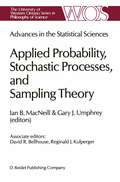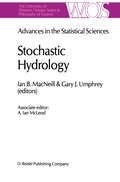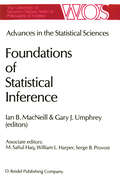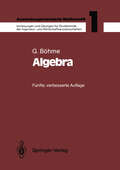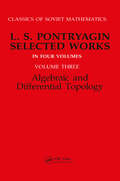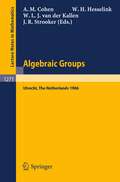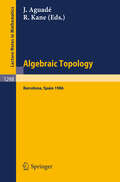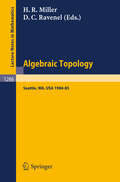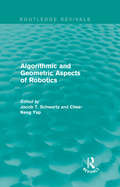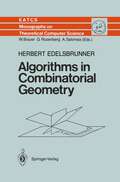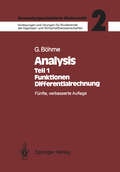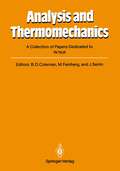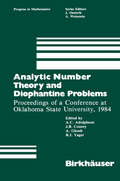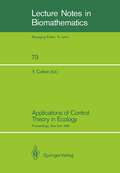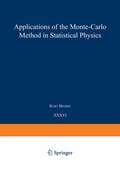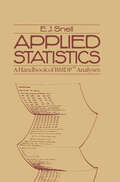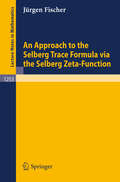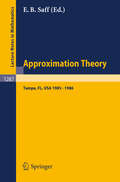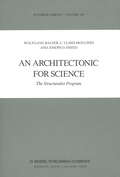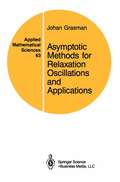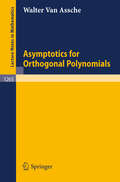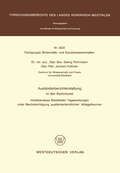- Table View
- List View
Advances in the Statistical Sciences: Volume I of the Festschrift in Honor of Professor V.M. Joshi’s 70th Birthday (The Western Ontario Series in Philosophy of Science #34)
by I. B. MacNeill G. UmphreyOn May 27-31, 1985, a series of symposia was held at The University of Western Ontario, London, Canada, to celebrate the 70th birthday of Pro fessor V. M. Joshi. These symposia were chosen to reflect Professor Joshi's research interests as well as areas of expertise in statistical science among faculty in the Departments of Statistical and Actuarial Sciences, Economics, Epidemiology and Biostatistics, and Philosophy. From these symposia, the six volumes which comprise the "Joshi Festschrift" have arisen. The 117 articles in this work reflect the broad interests and high quality of research of those who attended our conference. We would like to thank all of the contributors for their superb cooperation in helping us to complete this project. Our deepest gratitude must go to the three people who have spent so much of their time in the past year typing these volumes: Jackie Bell, Lise Constant, and Sandy Tarnowski. This work has been printed from "carnera ready" copy produced by our Vax 785 computer and QMS Lasergraphix printers, using the text processing software TEX. At the initiation of this project, we were neophytes in the use of this system. Thank you, Jackie, Lise, and Sandy, for having the persistence and dedication needed to complete this undertaking.
Advances in the Statistical Sciences: Volume IV Festschrift in Honor of Professor V. M. Joshi’s 70th Birthday (The Western Ontario Series in Philosophy of Science #37)
by I. B. MacNeill G. UmphreyOn May 27-31, 1985, a series of symposia was held at The University of Western Ontario, London, Canada, to celebrate the 70th birthday of Pro fessor V. M. Joshi. These symposia were chosen to reflect Professor Joshi's research interests as well as areas of expertise in statistical science among faculty in the Departments of Statistical and Actuarial Sciences, Economics, Epidemiology and Biostatistics, and Philosophy. From these symposia, the six volumes which comprise the "Joshi Festschrift" have arisen. The 117 articles in this work reflect the broad interests and high quality of research of those who attended our conference. We would like to thank alI of the contributors for their superb cooperation in helping us to complete this project. Our deepest gratitude must go to the three people who have spent so much of their time in the past year typing these volumes: Jackie BeU, Lise Constant, and Sandy Tamowski. This work has been printed from "camera ready" copy produced by our Vax 785 computer and QMS Lasergraphix printers, using the text processing software TEX. At the initiation of this project, we were neophytes in the use of this system. Thank you, J ackie, Lise, and Sandy, for having the persistence and dedication needed to complete this undertaking.
Advances in the Statistical Sciences: Volume II of the Festschrift in Honor of Professor V.M. Joshi’s 70th Birthday (The Western Ontario Series in Philosophy of Science #35)
by I. B. MacNeill G. UmphreyOn May 27-31, 1985, a series of symposia was held at The University of Western Ontario, London, Canada, to celebrate the 70th birthday of Pro fessor V. M. Joshi. These symposia were chosen to reflect Professor Joshi's research interests as well as areas of expertise in statistical science among faculty in the Departments of Statistical and Actuarial Sciences, Economics, Epidemiology and Biostatistics, and Philosophy. From these symposia, the six volumes which comprise the "Joshi Festschrift" have arisen. The 117 articles in this work reflect the broad interests and high quality of research of those who attended our conference. We would like to thank all of the contributors for their superb cooperation in helping us to complete this project. Our deepest gratitude must go to the three people who have spent so much of their time in the past year typing these volumes: Jackie Bell, Lise Constant, and Sandy Tarnowski. This work has been printed from "camera ready" copy produced by our Vax 785 computer and QMS Lasergraphix printers, using the text processing software TEX. At the initiation of this project, we were neophytes in the use of this system. Thank you, Jackie, Lise, and Sandy, for having the persistence and dedication needed to complete this undertaking.
Algebraic and Differential Topology
by R.V. GamkrelidzeAlgebraic and Differential Topology presents in a clear, concise, and detailed manner the fundamentals of homology theory. It first defines the concept of a complex and its Betti groups, then discusses the topolgoical invariance of a Betti group. The book next presents various applications of homology theory, such as mapping of polyhedrons onto other polyhedrons as well as onto themselves. The third volume in L.S. Pontryagin's Selected Works, this book provides as many insights into algebraic topology for today's mathematician as it did when the author was making his initial endeavors into this field.
Algebraic and Differential Topology
by R.V. GamkrelidzeAlgebraic and Differential Topology presents in a clear, concise, and detailed manner the fundamentals of homology theory. It first defines the concept of a complex and its Betti groups, then discusses the topolgoical invariance of a Betti group. The book next presents various applications of homology theory, such as mapping of polyhedrons onto other polyhedrons as well as onto themselves. The third volume in L.S. Pontryagin's Selected Works, this book provides as many insights into algebraic topology for today's mathematician as it did when the author was making his initial endeavors into this field.
Algebraic Groups. Utrecht 1986: Proceedings of a Symposium in Honour of T.A. Springer (Lecture Notes in Mathematics #1271)
by Arjeh M. Cohen Wim H. Hesselink Wilberd L. J. Van Der Kallen Jan R. StrookerFrom 1-4 April 1986 a Symposium on Algebraic Groups was held at the University of Utrecht, The Netherlands, in celebration of the 350th birthday of the University and the 60th of T.A. Springer. Recognized leaders in the field of algebraic groups and related areas gave lectures which covered wide and central areas of mathematics. Though the fourteen papers in this volume are mostly original research contributions, some survey articles are included. Centering on the Symposium subject, such diverse topics are covered as Discrete Subgroups of Lie Groups, Invariant Theory, D-modules, Lie Algebras, Special Functions, Group Actions on Varieties.
Algebraic Topology. Barcelona 1986: Proceedings of a Symposium held in Barcelona, April 2-8, 1986 (Lecture Notes in Mathematics #1298)
by J. Aguade R. KaneAlgebraic Topology. Seattle 1985: Proceedings of a Workshop held at the University of Washington, Seattle, 1984-85 (Lecture Notes in Mathematics #1286)
by Haynes R. Miller Douglas C. RavenelDuring the Winter and spring of 1985 a Workshop in Algebraic Topology was held at the University of Washington. The course notes by Emmanuel Dror Farjoun and by Frederick R. Cohen contained in this volume are carefully written graduate level expositions of certain aspects of equivariant homotopy theory and classical homotopy theory, respectively. M.E. Mahowald has included some of the material from his further papers, represent a wide range of contemporary homotopy theory: the Kervaire invariant, stable splitting theorems, computer calculation of unstable homotopy groups, and studies of L(n), Im J, and the symmetric groups.
Algorithmic and Geometric Aspects of Robotics (Routledge Revivals)
by Jacob T. Schwartz Chee-Keng YapFirst published in 1987, the seven chapters that comprise this book review contemporary work on the geometric side of robotics. The first chapter defines the fundamental goal of robotics in very broad terms and outlines a research agenda each of whose items constitutes a substantial area for further research. The second chapter presents recently developed techniques that have begun to address the geometric side of this research agenda and the third reviews several applied geometric ideas central to contemporary work on the problem of motion planning. The use of Voronoi diagrams, a theme opened in these chapters, is explored further later in the book. The fourth chapter develops a theme in computational geometry having obvious significance for the simplification of practical robotics problems — the approximation or decomposition of complex geometric objects into simple ones. The final chapters treat two examples of a class of geometric ‘reconstruction’ problem that have immediate application to computer-aided geometric design systems.
Algorithmic and Geometric Aspects of Robotics (Routledge Revivals)
by Jacob T. Schwartz Chee-Keng YapFirst published in 1987, the seven chapters that comprise this book review contemporary work on the geometric side of robotics. The first chapter defines the fundamental goal of robotics in very broad terms and outlines a research agenda each of whose items constitutes a substantial area for further research. The second chapter presents recently developed techniques that have begun to address the geometric side of this research agenda and the third reviews several applied geometric ideas central to contemporary work on the problem of motion planning. The use of Voronoi diagrams, a theme opened in these chapters, is explored further later in the book. The fourth chapter develops a theme in computational geometry having obvious significance for the simplification of practical robotics problems — the approximation or decomposition of complex geometric objects into simple ones. The final chapters treat two examples of a class of geometric ‘reconstruction’ problem that have immediate application to computer-aided geometric design systems.
Algorithms in Combinatorial Geometry (Monographs in Theoretical Computer Science. An EATCS Series #10)
by Herbert EdelsbrunnerComputational geometry as an area of research in its own right emerged in the early seventies of this century. Right from the beginning, it was obvious that strong connections of various kinds exist to questions studied in the considerably older field of combinatorial geometry. For example, the combinatorial structure of a geometric problem usually decides which algorithmic method solves the problem most efficiently. Furthermore, the analysis of an algorithm often requires a great deal of combinatorial knowledge. As it turns out, however, the connection between the two research areas commonly referred to as computa tional geometry and combinatorial geometry is not as lop-sided as it appears. Indeed, the interest in computational issues in geometry gives a new and con structive direction to the combinatorial study of geometry. It is the intention of this book to demonstrate that computational and com binatorial investigations in geometry are doomed to profit from each other. To reach this goal, I designed this book to consist of three parts, acorn binatorial part, a computational part, and one that presents applications of the results of the first two parts. The choice of the topics covered in this book was guided by my attempt to describe the most fundamental algorithms in computational geometry that have an interesting combinatorial structure. In this early stage geometric transforms played an important role as they reveal connections between seemingly unrelated problems and thus help to structure the field.
Analysis and Thermomechanics: A Collection of Papers Dedicated to W. Noll on His Sixtieth Birthday
by Bernard D. Coleman Martin Feinberg James SerrinAnalytic Number Theory and Diophantine Problems: Proceedings of a Conference at Oklahoma State University, 1984 (Progress in Mathematics #70)
by A. C. Adolphson A. Ghosh J. B. Conrey R. I. JagerA conference on Analytic Number Theory and Diophantine Problems was held from June 24 to July 3, 1984 at the Oklahoma State University in Stillwater. The conference was funded by the National Science Foundation, the College of Arts and Sciences and the Department of Mathematics at Oklahoma State University. The papers in this volume represent only a portion of the many talks given at the conference. The principal speakers were Professors E. Bombieri, P. X. Gallagher, D. Goldfeld, S. Graham, R. Greenberg, H. Halberstam, C. Hooley, H. Iwaniec, D. J. Lewis, D. W. Masser, H. L. Montgomery, A. Selberg, and R. C. Vaughan. Of these, Professors Bombieri, Goldfeld, Masser, and Vaughan gave three lectures each, while Professor Hooley gave two. Special sessions were also held and most participants gave talks of at least twenty minutes each. Prof. P. Sarnak was unable to attend but a paper based on his intended talk is included in this volume. We take this opportunity to thank all participants for their (enthusiastic) support for the conference. Judging from the response, it was deemed a success. As for this volume, I take responsibility for any typographical errors that may occur in the final print. I also apologize for the delay (which was due to the many problems incurred while retyping all the papers). A. special thanks to Dollee Walker for retyping the papers and to Prof. W. H. Jaco for his support, encouragement and hard work in bringing the idea of the conference to fruition.
Applications of Control Theory in Ecology: Proceedings of the Symposium on Optimal Control Theory held at the State University of New York, Syracuse, New York, August 10–16, 1986 (Lecture Notes in Biomathematics #73)
by Yosef CohenControl theory can be roughly classified as deterministic or stochastic. Each of these can further be subdivided into game theory and optimal control theory. The central problem of control theory is the so called constrained maximization (which- with slight modifications--is equivalent to minimization). One can then say, heuristically, that the major problem of control theory is to find the maximum of some performance criterion (or criteria), given a set of constraints. The starting point is, of course, a mathematical representation of the performance criterion (or criteria)- sometimes called the objective functional--along with the constraints. When the objective functional is single valued (Le. , when there is only one objective to be maximized), then one is dealing with optimal control theory. When more than one objective is involved, and the objectives are generally incompatible, then one is dealing with game theory. The first paper deals with stochastic optimal control, using the dynamic programming approach. The next two papers deal with deterministic optimal control, and the final two deal with applications of game theory to ecological problems. In his contribution, Dr. Marc Mangel applies the dynamic proQramming approach, as modified by his recent work--with Dr. Colin Clark, from the University of British Columbia (Mangel and Clark 1987}*--to modelling the "behavioral decisions" of insects. The objective functional is a measure of fitness. Readers interested in detailed development of the subject matter may consult Mangel (1985). My contributions deal with two applications of optimal control theory.
Applications of the Monte Carlo Method in Statistical Physics (Topics in Current Physics #36)
by A. Baumgärtner K. Binder J. P. Hansen M. H. Kalos K. Kehr D. P. Landau D. Levesque H. Müller-Krumbhaar C. Rebbi Y. Saito K. Schmidt D. Stauffer J. J. WeisApplied Statistics: A Handbook of BMDP™ Analyses
by David CoxThis handbook is a realization of a long term goal of BMDP Statistical Software. As the software supporting statistical analysis has grown in breadth and depth to the point where it can serve many of the needs of accomplished statisticians it can also serve as an essential support to those needing to expand their knowledge of statistical applications. Statisticians should not be handicapped by heavy computation or by the lack of needed options. When Applied Statistics, Principle and Examples by Cox and Snell appeared we at BMDP were impressed with the scope of the applications discussed and felt that many statisticians eager to expand their capabilities in handling such problems could profit from having the solutions carried further, to get them started and guided to a more advanced level in problem solving. Who would be better to undertake that task than the authors of Applied Statistics? A year or two later discussions with David Cox and Joyce Snell at Imperial College indicated that a wedding of the problem statements and suggested solutions with control language to accomplish these analyses would further the learning process for many statisticians. They were willing to undertake the project. Joyce Snell has done an excellent job of melding the two approaches and has carried many of the problems a step further by suggesting alternate approaches and follow-up analyses.
An Approach to the Selberg Trace Formula via the Selberg Zeta-Function (Lecture Notes in Mathematics #1253)
by Jürgen FischerThe Notes give a direct approach to the Selberg zeta-function for cofinite discrete subgroups of SL (2,#3) acting on the upper half-plane. The basic idea is to compute the trace of the iterated resolvent kernel of the hyperbolic Laplacian in order to arrive at the logarithmic derivative of the Selberg zeta-function. Previous knowledge of the Selberg trace formula is not assumed. The theory is developed for arbitrary real weights and for arbitrary multiplier systems permitting an approach to known results on classical automorphic forms without the Riemann-Roch theorem. The author's discussion of the Selberg trace formula stresses the analogy with the Riemann zeta-function. For example, the canonical factorization theorem involves an analogue of the Euler constant. Finally the general Selberg trace formula is deduced easily from the properties of the Selberg zeta-function: this is similar to the procedure in analytic number theory where the explicit formulae are deduced from the properties of the Riemann zeta-function. Apart from the basic spectral theory of the Laplacian for cofinite groups the book is self-contained and will be useful as a quick approach to the Selberg zeta-function and the Selberg trace formula.
Approximation Theory. Tampa: Proceedings of a Seminar held in Tampa, Florida, 1985 - 1986 (Lecture Notes in Mathematics #1287)
by Edward B. SaffArbeitslosigkeit und Arbeitsangebot in Österreich (Linzer Universitätsschriften #12)
Der vorliegende Band enthiilt die Referate und Koreferate, die im Oktober 1986 auf einem zweitllgigen Symposium Uber "Arbeitslosigkeit und Arbeits angebot in Osterreich" an der Universitiit Linz vorgetragen wurden. Die Be- trage basieren auf !aufenden Arbeiten und Zwischenergebnissen aus dem Fo- schungsschwerpunkt "Dynamik der Arbeitslosigkeit und Beschaftigung", einem auf fUnf Jahre geplanten Forschungsprogramm, das im Januar 1985 yom Fonds zur Forderung der wissenschaftlichen Forschung bewilligt und Mitte 1985 begonnen wurde. Das Projekt ist von dem Gedanken getragen, daB Fragen der Arbeitslosigkeit und Beschaftigung, die lange Zeit nieht sehr dringlich erschienen, nun intensiver Beachtung erfordem, da sie sich in allen Landem und nun auch in Osterreich als besonders hartnackiges Problem erweisen. 1m letzten Jahrzehnt hat die Arbeitsmarktforschung in Osterreich rasch an Umfang zugenommen, wobei vor allem Arbeiten aus dem Oste- reichischen Institut fUr Wirtschaftsforschung, dem Osterreichischen Statist- schen Zentralamt, dem Institut fUr Hohere Studien, dem Institut fUr Arbeit- marktpolitik an der Universitat Linz und okonomische und soziologische Untersuchungen an der Universitiit Graz zu erwahnen sind. Durch diese wissenschaftlichen Aktivitiiten, aber auch durch wichtige theoretische AnstoBe aus dem Ausland sowie durch eine wesentliche Ausweitung der yom Sozia- ministerium und den Arbeitsamtem zur VerfUgung gestellten Daten haben sich neue Moglichkeiten entwickelt, das Arbeitsmarktgeschehen in groBerem Detail zu analysieren. Wir sind dem Fonds zur Forderung der wissenschaf- lichen Forschung zu Dank verpflichtet, daB er durch Bewilligung des Schwe- punkts eine grUndliche Bearbeitung einiger dieser Themen ermoglicht hat.
An Architectonic for Science: The Structuralist Program (Synthese Library #186)
by W. Balzer C.U. Moulines J.D. SneedThis book has grown out of eight years of close collaboration among its authors. From the very beginning we decided that its content should come out as the result of a truly common effort. That is, we did not "distribute" parts of the text planned to each one of us. On the contrary, we made a point that each single paragraph be the product of a common reflection. Genuine team-work is not as usual in philosophy as it is in other academic disciplines. We think, however, that this is more due to the idiosyncrasy of philosophers than to the nature of their subject. Close collaboration with positive results is as rewarding as anything can be, but it may also prove to be quite difficult to implement. In our case, part of the difficulties came from purely geographic separation. This caused unsuspected delays in coordinating the work. But more than this, as time passed, the accumulation of particular results and ideas outran our ability to fit them into an organic unity. Different styles of exposition, different ways of formalization, different levels of complexity were simultaneously present in a voluminous manuscript that had become completely unmanageable. In particular, a portion of the text had been conceived in the language of category theory and employed ideas of a rather abstract nature, while another part was expounded in the more conventional set-theoretic style, stressing intui tivity and concreteness.
Asymptotic Methods for Relaxation Oscillations and Applications (Applied Mathematical Sciences #63)
by Johan GrasmanIn various fields of science, notably in physics and biology, one is con fronted with periodic phenomena having a remarkable temporal structure: it is as if certain systems are periodically reset in an initial state. A paper of Van der Pol in the Philosophical Magazine of 1926 started up the investigation of this highly nonlinear type of oscillation for which Van der Pol coined the name "relaxation oscillation". The study of relaxation oscillations requires a mathematical analysis which differs strongly from the well-known theory of almost linear oscillations. In this monograph the method of matched asymptotic expansions is employed to approximate the periodic orbit of a relaxation oscillator. As an introduction, in chapter 2 the asymptotic analysis of Van der Pol's equation is carried out in all detail. The problem exhibits all features characteristic for a relaxation oscillation. From this case study one may learn how to handle other or more generally formulated relaxation oscillations. In the survey special attention is given to biological and chemical relaxation oscillators. In chapter 2 a general definition of a relaxation oscillation is formulated.
Asymptotics for Orthogonal Polynomials (Lecture Notes in Mathematics #1265)
by Walter Van AsscheRecently there has been a great deal of interest in the theory of orthogonal polynomials. The number of books treating the subject, however, is limited. This monograph brings together some results involving the asymptotic behaviour of orthogonal polynomials when the degree tends to infinity, assuming only a basic knowledge of real and complex analysis. An extensive treatment, starting with special knowledge of the orthogonality measure, is given for orthogonal polynomials on a compact set and on an unbounded set. Another possible approach is to start from properties of the coefficients in the three-term recurrence relation for orthogonal polynomials. This is done using the methods of (discrete) scattering theory. A new method, based on limit theorems in probability theory, to obtain asymptotic formulas for some polynomials is also given. Various consequences of all the results are described and applications are given ranging from random matrices and birth-death processes to discrete Schrödinger operators, illustrating the close interaction with different branches of applied mathematics.
